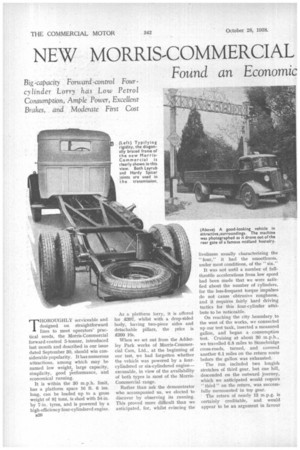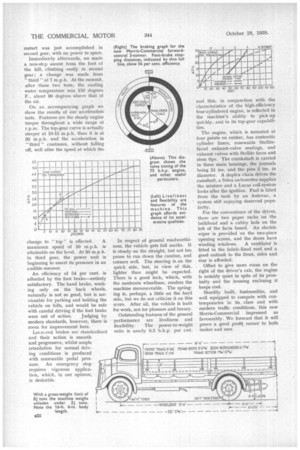NEW MORRIS-COMMERCIAL 5-TONNER
Page 30

Page 31

Page 32

If you've noticed an error in this article please click here to report it so we can fix it.
Found an Economic
Proposition on All Counts Big-capacity Forward-control Four cylinder Lorry has Low Petrol Consumption, Ample Power, Excellent' Brakes, and Moderate First Cost THOROUGHLY serviceable and designed on straightforward lines to meet operators' practical needs, the Morris-Commercial forward-control 5-tonner, introduced last month and described in our issue dated September 30, should win considerable popularity. It has numerous attractions, among which may be named low weight, large capacity, simplicity, good performance, and economical running.
It is within the 30 m.p.h. limit, has a platform space JO ft. 6 ins, long, can be loaded up to a gross weight of 81 tons, is shod with 34-in. by 7-in. tyres, and is powered by a high-efficiency four-cylindered engine. As a platform lorry, it is offered for £397, whilst with a drop-sided body, having two-piece sides and detachable pillars, the price is £309 10s.
When we set out from the Adderley Park works of Morris-Commercial Cars, Ltd., at the beginning of our test, we had forgotten whether the vehicle was powered by a fourcylindered or six-cylindered engine— excusable, in view of the availability of both types in most of the MorrisCommercial range.
Rather than ask the demonstrator who accompanied us, we elected to discover by observing its running. This proved more difficult than we anticipated, for, whilst evincing the liveliness usually characterizing the "four," it had the smoothness, under most conditions, of the "six."
It was not until a number of fullthrottle accelerations from low speed had been made that we were satisfied about the number of cylinders, for the less-frequent torque impulses do not cause obtrusive roughness, and it requires fairly hard driving tactics for this four-cylinder attribute to be noticeable.
On reaching the city boundary to the west of the works, we connected up our test tank, inserted a measured gallon, and began a consumption test. Cruising at about 30 m.p.h., we travelled 6.8 miles to Stonelnidge cross-roads, turned, and covered another 6.1 miles on the return route before the gallon was exhausted.
The run included two longish stretches of third gear, but one hill, descended on the outward journey, which we anticipated would require " third " on the return, was successfully surmounted in top gear.
The return of nearly 13 m.p.g. is certainly creditable, and would appear to be an argument in favour of four cylinders, as well as that based on the space thus saved.
With regard to the third ratio, the downward changes into it attracted our attention during this test. The gear is described by the maker as " Traffic-top." It affords a gearbox reduction of 1.836 to 1, so it is not unduly close to direct drive, although near enough to enable quick changes to be made.
The third-speed pinions are doublehelical gears, in constant mesh, of course, and having the selector fork between the two sets of teeth on the mainshaft wheel. The assembly slides en bloc, the mainshaft wheel being splined and the other loose on the layshaft. In one extreme position dogs on the primary shaft are engaged, whilst, in the other, the teeth of the second-speed layshaft wheel are picked up by internal teeth on the corresponding third-speed wheel. '
For our hill-climb test we chose Coleshill main street, which has a maximum gradient of I in 9-1 by measurement. Striking this acclivity half way up, we stopped at the point of maximum severity to try the hand brake and to effect a restart.
The hand brake easily held the vehicle from running back whilst the restart was just accomplished in second gear, with no power to spare.
Immediately afterwards, we made a non-stcp ascent from the foot of the hill, climbing .easily in second gear ; a change was made from "third ".at 7 m.p.h. At the summit, after these two tests, the cooling water temperature was 150 degrees F., about 90 degrees above that of the air.
On an accompanying graph we show the results of our acceleration tests. Features are the steady engine torque throughout a wide range of r.p.m. The top-gear curve is actually steeper at 10-15 m.p.h. than it is at 30 m.p.h. and the acceleration in " third " continues, without falling off, well after the speed at which the change to " top " is effected. A maximum speed of 50 m.p.h. is attainable on the level. At 30 m.p.h. in third gear, the power unit is beginning to assert its presence in an audible manner.
An efticiency of 54 per cent, is afforded by the foot brake—entirely satisfactory. The hand brake, working only on the back wheels, naturally is not so good, but is serviceable for parking and holding the vehicle on hills, and would be safe with careful driving if the foot brake were out of action. Judging by modern standards, however, there is room for improvement here.
Locid.eed brakes are standardized and their action is smooth and progressive, whilst ample retardation for normal driving conditions is produced with reasonable pedal pressure. An emergency stop requires vigorous application, which, in our opinion, is desirable. In respect of general roadworthiness, the vehicle gets full marks. It is steady on the straight, but not too prone to run down the camber, and corners well. The steering is on the quick side, but, in view of this, lighter than might be expected. There is a good lock, which, with the moderate wheelbase, renders the machine manccuvrable. The springing is, perhaps, a little on the hard side, but we do not criticize it on this score. After all, the vehicle is built for work, not for pleasure and luxury.
Outstanding features of the general performance are liveliness and flexibility. The power-to-weight ratio is nearly 0.5 b.h.p. per cwt. and this, in conjunction with the characteristics of the high-efficiency four-cylindered engine, is reflected in the machine's ability to pick-up quickly, and in its top-gear capabilities.
The engine, which is mounted at four points on rubber, has austenitic cylinder liners, renewable Stellitefaced exhaust-valve seatings, and exhaust valves with Stellite faces and stem tips. The crankshaft is carried in three main bearings, the journals being 2i ins, and the pins 2 ins, in diameter. A duplex chain drives the camshaft, a Solex carburetter supplies the mixture and a Lucas coil-system looks after the ignition. Fuel is lifted from the tank by an Autovac, a system still enjoying deserved popularity.
For the convenience of the driver,
there are two paper racks 'on the bulkhead and a cubby hole on the left of the facia board. An electric wiper is provided on the two-piece opening screen, and the doors have winding windows. A ventilator is fitted in the fabric-lined roof and a good outlook to the front, sides and rear is afforded.
Offset to give more room on the right of the driver's cab, the engine is notably quiet in spite of its proximity and the housing enclosing it keeps cool.
Sturdily built, businesslike, and well equipped to compete with contemporaries in its class and with modern traffic conditions, this new Morris-Commercial impressed us favourably. We forecast that it will prove a good profit earner to both maker and user.




















































































